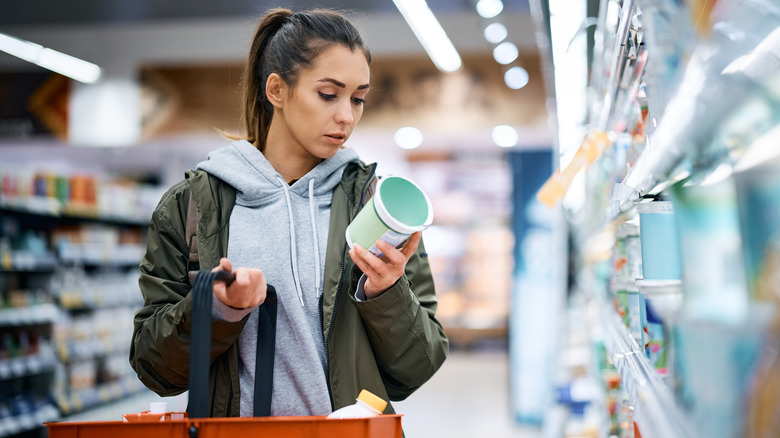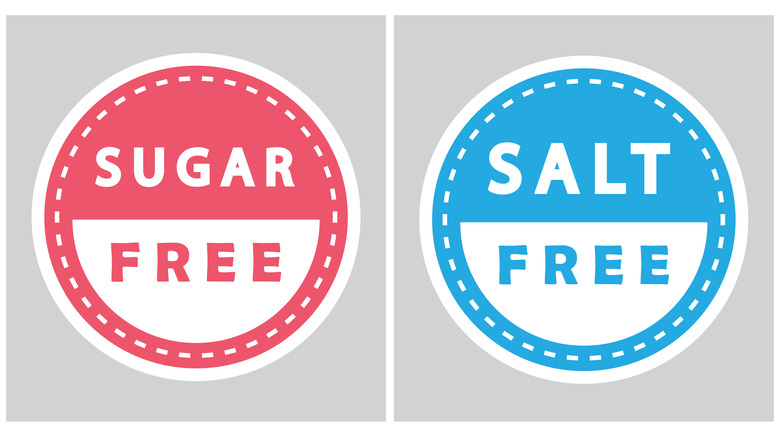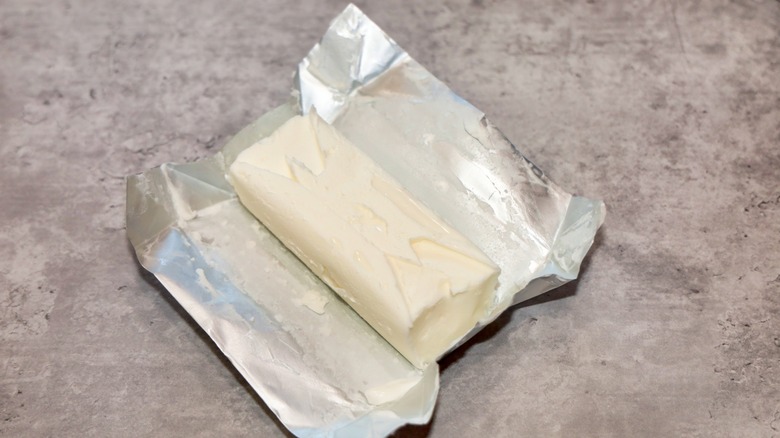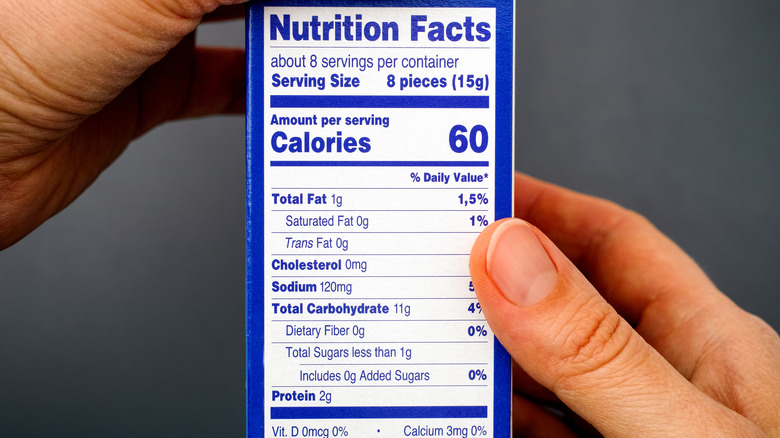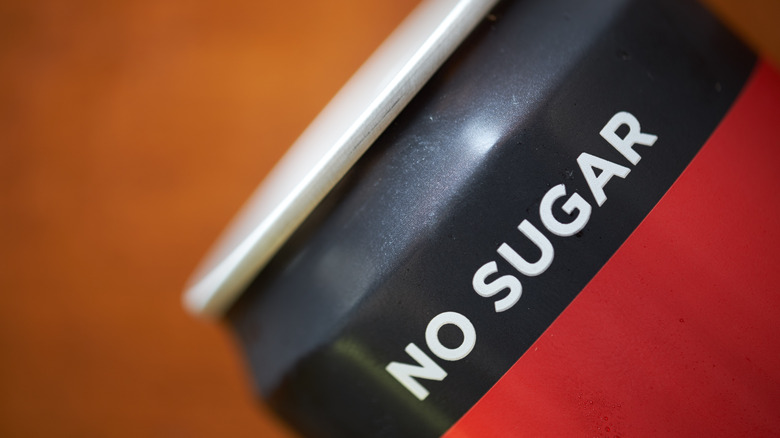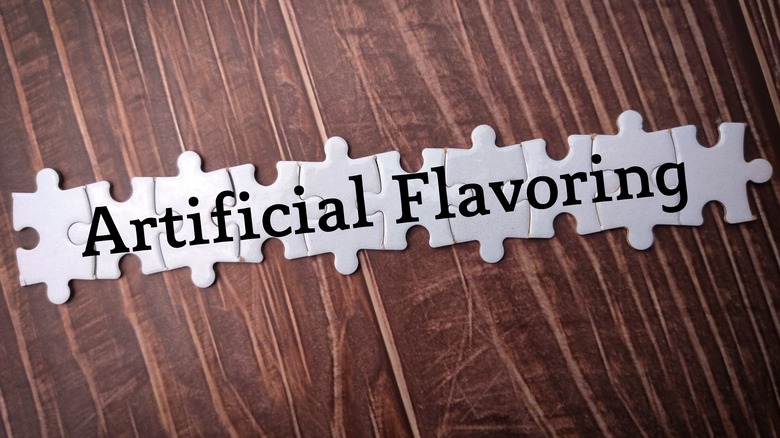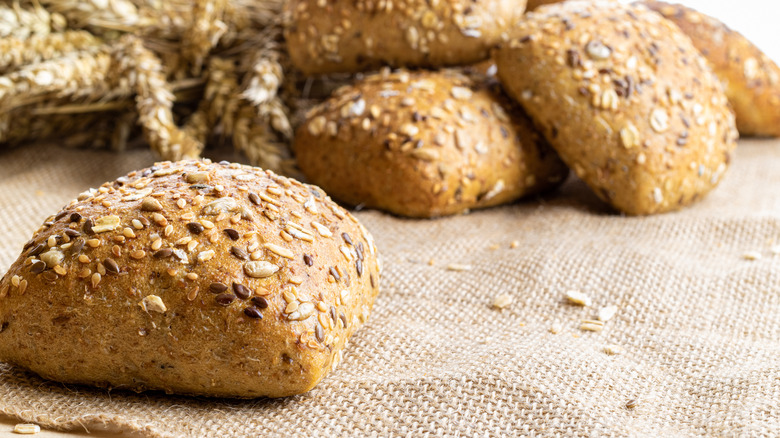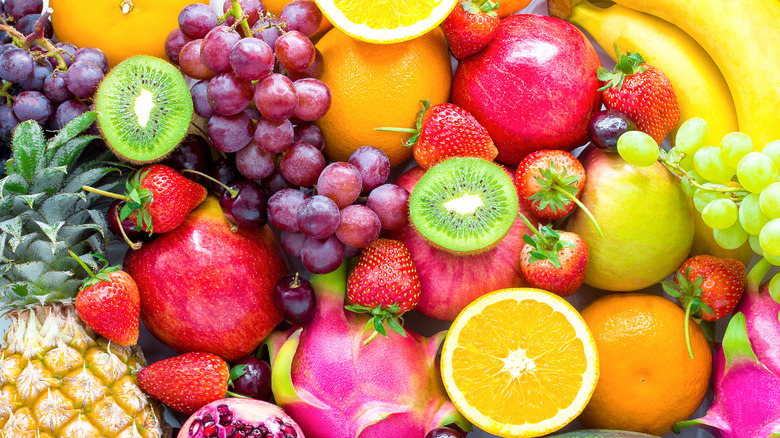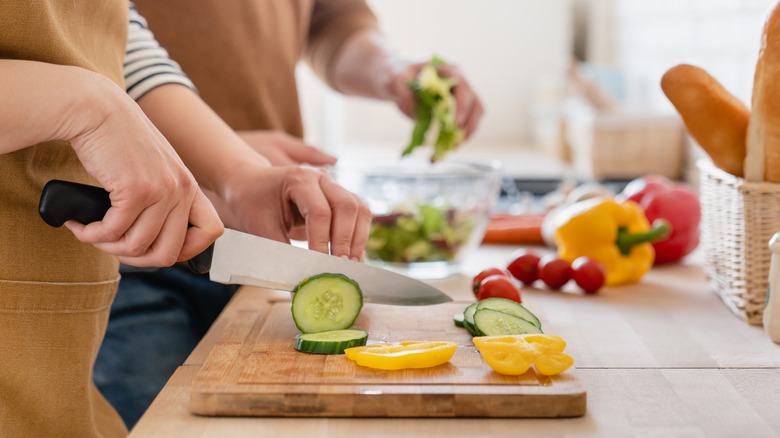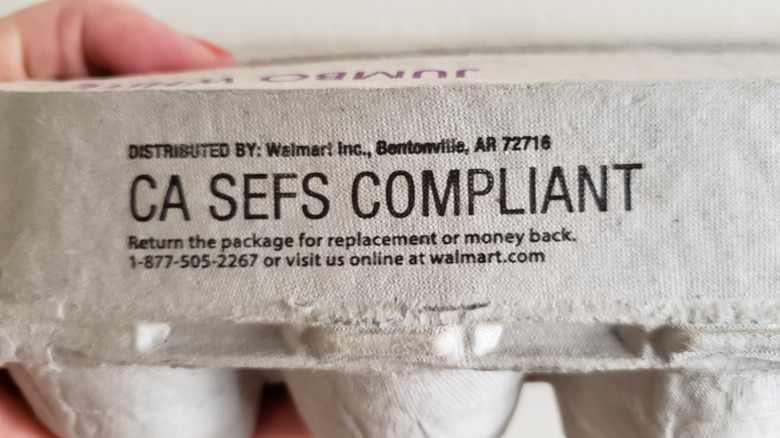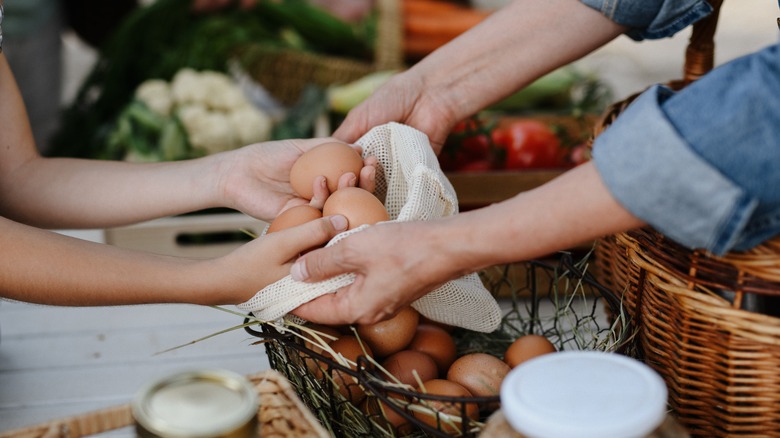12 Words On Packaged Foods That Can Be Major Red Flags
Nutrition panels and ingredient labels are on food packaging to help consumers make smarter decisions about the foods they buy — but all the other text on the packaging is there for marketing purposes, to help the product be more visible, and to get consumers to buy it. The U.S. Food and Drug Administration (FDA) and the U.S. Department of Agriculture (USDA) both play roles in what claims can be made on food packaging, but those roles have had limited effects. Packaging claims have to be truthful and can't violate the requirements set by whichever agency oversees a particular type of food — but those requirements may not describe what you think they do.
So, when you buy food, you have to look out for yourself and be a bit skeptical about any claims you see on the packaging. Food manufacturers have an unfortunate history of promoting claims that turned out to be less clear-cut than consumers assumed. You've got to learn what various phrases and terms mean and compare them with what's actually in the nutrition label, rather than assuming brands have your best interests at heart. Start by learning about these 12 words and phrases on packaged foods that can be major red flags.
1. Reduced or light
One of the more common claims on food packaging is that the food is low in something or has a reduced level of something, like sodium or sugar. You may also see terms like "light" floating around, too. Whether the product claims to be reduced sodium, "light" in terms of fat content or something else, flip that package over to take a look at the nutrition label. Terms like "reduced" and "light" don't mean that much, and they certainly don't mean a product is actually low in a particular ingredient. Even "low" isn't that descriptive, and FoodNavigator reports that all of these terms can be misleading because consumers don't know what they actually refer to.
The FDA (PDF warning) regulates sodium claims on packaging, so you do have some help in interpreting those. For example, something marketed as "low sodium" needs to have 140 milligrams or fewer of sodium per serving. Yet some of the approved terms are still rather vague; "reduced sodium," for example, just means the product has "at least 25% less sodium than the regular product." Those other terms like "light" can have a basically regulated meaning, but they may hide some nasty news. Beaufort Memorial says that "light" products should have 50% less fat (or an even lower percentage) than the regular version of the product, but that same "light" product could have extra sugar to make up for the difference in taste.
2. Hydrogenated
The use of partially and fully hydrogenated oils allows manufacturers to increase the shelf life of a product, including creating culinary fats like shortening that can be stored at room temperature. Hydrogenated oils are still common ingredients in many processed foods even though the FDA removed its "generally recognized as safe" label from partially hydrogenated oils (PHOs) in 2015, and banned the use of PHOs effective in 2020. PHOs in food created trans fats, a dangerous form of fat that has adverse effects on your good and bad cholesterol levels. So if PHOs have been banned for a few years now, why is the word "hydrogenated" still such a red flag?
The reason is that fully hydrogenated fats, which don't create trans fats, are still considered to be saturated fats. Plus, there isn't a lot of research on fully hydrogenated oil's long-term effects on cholesterol and health, according to VeryWell Fit. Finally, fully hydrogenated oils tend to be used in highly processed foods such as fast food, according to Consumer Reports. So while the product may not be as dangerous as one containing PHOs, it's still not the best thing you could eat for your health.
3. Unrealistic serving numbers or sizes
Okay, so this is not exactly a word, but the numbers you see on food packaging are important, too. Particularly the serving sizes and the number of servings per package, because if either of those seem unrealistic, you may want to put the package back on the shelf. The FDA recently required food producers to be more realistic about the number of servings a package can contain and how big those servings should be. Unfortunately, you can still find products where the serving size is nothing like what a typical person would eat, and that can have a bad effect on your health if you aren't paying attention. Instant ramen packages are a good example; Reddit has a number of threads in which people complain about how one package is supposed to feed two people when almost no one eats only half a package.
The ramen is also an example of why this weird labeling happens. Dividing one serving into two servings means that the overall sodium and fat amounts are lower per serving. This isn't a new phenomenon; the Washington Post reported on this back in 1987. But as AARP notes, if you eat what you typically would eat, you'd be getting much more sodium, for example, than the per-serving nutrition information would lead you to believe.
4. No added sugar and sugar free
These two phrases aren't exactly bad in and of themselves. However, they can be misleading if a consumer doesn't realize what they imply. "No added sugar" means that no additional sugars have been added. Whatever sugar the basic ingredients had is all you'll find in the food, but it doesn't mean the product is free of sugar, or that other sweeteners like stevia haven't been added. "No added sugars" helps if you're aiming to reduce your sugar intake, and the FDA revamped nutrition labels a few years ago to include an "added sugars" category. But if you're trying to find foods that don't taste as sweet, this might not be much help.
"Sugar free," according to the American Heart Association, means that the product doesn't contain more than 0.5 grams of either naturally occurring or added sugars. It doesn't mean that the product doesn't contain natural or artificial sugar substitutes. But the real issue is that potential 0.5 grams of sugar per serving. Remember that the serving sizes on the nutrition label might not match your concept of a serving of that food. If you eat more than one serving, you'll get more than half a gram of sugar. And if you can't have any sugar, for whatever reason, then "sugar free" is a phrase you need to approach very carefully.
5. Anything about included flavorings
Artificial and natural flavorings on a food package can be red flags because you don't really know what you're getting. Even natural flavorings aren't necessarily derived from what you think they are, especially given the advances in biotechnology, according to Popular Science. It's not uncommon now to find natural flavoring made by combining elements from one food with enzymes that convert the taste to match that of another food. For example, grapefruit flavoring from grapefruits is expensive and difficult to produce in large quantities. But combining a chemical compound derived from oranges with a specific enzyme can produce a decent grapefruit flavor. The compounds used can often seem like artificial chemicals because the names seem so strange; in fact, an Illinois law firm filed a lawsuit in 2018 against LaCroix, claiming that the "natural flavors" were actually artificial and dangerous. However, the flavorings listed in the lawsuit could all be found in natural sources, and in 2020, the law firm dropped the lawsuit.
As for artificial flavorings, those are actually pretty safe, says Scientific American. All the ingredients are tested and known to be safe to use. However, Dr. Andrew Weil suggests inspecting the ingredient list carefully as the inclusion of artificial flavors could signal that the product contains additional additives like high-fructose corn syrup.
6. Nectar and juice drink
While the benefits of fruit juice have been the subject of debate, there's no doubt that many people still like to have some as a treat or alongside their breakfast. And real juice does contain vitamins and minerals, says Consumer Reports, so it's not the worst thing you could drink. But you have to be careful about the specific terms the packaging uses: 100% juice means what it says, but make sure that the juice you're drinking is from the fruit you're assuming it is. That 100% juice could be from a combination of apple, white grape juice, and pear juice, notes Mental Floss. This could be an issue if you're taking medications that interact with different fruit juices.
You may also find that your glass of 100% juice contains flavoring, as one woman found out in 2011 when she learned that her favorite juice brand, supposedly 100% orange juice, contained what's called a flavor pack. This is a compound made from orange oil and orange essence that's added to juice to enhance the flavor. Finally, if the bottle you're buying is labeled with "juice drink," "nectar," "made with real juice," or something similar, check that ingredient list immediately. Those terms indicate that the juice is not actually all juice, but a blend of flavoring, some juice, sugar, additives, and more. Michigan State University says these drinks can have as little as 5% juice.
7. Anything trademarked or branded in the ingredients
This is something that you might not have realized was a thing: branded or trademarked ingredients. Sure, you've no doubt seen cookie and candy brands in special ice cream mixes, but that's not what this particular issue is about. Some companies have named and trademarked ingredients specifically for use in other products, or even that company's own products, often to help with product recognition and sales. For example, Healthfully describes a probiotic bacteria called Bifidus regularis that's used in Dannon's Activia yogurt. B. regularis is a trademarked name for a strain of probiotic bacteria that you can find in human guts. However, using the trademarked name "Bifidus regularis" lets Activia stand out because it's the only brand that is legally allowed to use "Bifidus regularis" in its ingredient list. The company can truthfully claim it's the only one whose products contain that probiotic, notes Healthfully, but that's because of the legal standing only.
Including branded ingredients can often help sales, according to FoodNavigator, due to the name recognition. When NutraSweet was still popular, for example, having NutraSweet in your product's ingredient list could help nudge people to buy your product instead of a competitor's version. When you look at a food product's packaging or ingredient label, be wary of how the packaging promotes a certain ingredient, and whether that ingredient is trademarked. There may be nothing special about the specific named ingredient other than the fact that it has a brand name.
8. Multigrain and whole grain
These terms sound healthy, but few consumers have an idea of what they really mean. And according to a 2020 study, few are able to determine whether a product contains whole grains. Whole grains are those with all parts of the grain intact except the hull, as opposed to refined grains, which have parts like the bran and germ removed. You want to eat whole grains as the bran and other parts provide a good amount of nutrition, including fiber.
But that's a problem when looking at food labels, as products can use terms like "multigrain" and "whole grain" rather freely. A product has to contain only a tiny bit of whole grains to be truthfully labeled as "whole grain," according to a report published by KSAT, which also notes that "multigrain" doesn't mean much. Yet according to that 2020 study, consumers often chose a less healthy product when asked to identify which of two cereals contained more whole grains. The study participants tended to choose the product that had fewer whole grains but that claimed to be whole grain, over a product that contained a good amount of whole grains but made no claims on the label. What should you do if you want a whole-grain product? Look for a phrase such as 100% whole grain, according to KSAT. You can also check the ingredient label to see if whole grains are listed as the first or second ingredient, according to Harvard Health.
9. Made with real fruit
Of all the nutritional claims a food label could make, you'd think "made with real fruit" and its ilk would be among the more reliable phrases as it's so straightforward. Nope. This, too, is a problematic phrase, and in fact, the Academy of Nutrition and Dietetics requested that the FDA review this phrase in 2018. The problem is three-fold. First, a product could have real fruit in it, but not the fruit you think it has. For example, a California woman filed a lawsuit against General Mills in 2012, claiming that the company's Strawberry Fruit Roll-Ups did not contain strawberries and were instead made with pears (via NBC News). Second, the phrase makes it sound like a substantial amount of fruit was used, but that's not always the case, either. For instance, FoodNavigator recalled a 2010 recommendation given to Kellogg to remove the "made with real fruit" phrase from Pop-Tart packaging because the product could contain as little as 2% fruit.
Third, the fruit in question could have been so processed that one could question whether it still counted as real fruit. The classic example here are "blueberry bits," which are usually small balls made with things like oils and coloring but can occasionally contain tiny bits of blueberries. If you want to buy a product that supposedly has blueberries, check the ingredient label before you buy and beware of phrases like blueberry bits, blueberry crunchlets, and fruit filling (via CHI Health).
10. Natural
Want to give a truth-in-advertising advocate a headache? Label your product "natural." This is one of the worst terms to deal with because it means absolutely nothing despite its apparent promise of beneficial nutrition or production. And even when the term is supposed to mean something — both the USDA and FDA barely define the term as not being artificial — claims that a food product is "natural" really aren't checked, according to the University of Minnesota. As a result, it's not unusual to find "natural" products with some distinctly unnatural ingredients. Consumer Reports conducted a survey and product investigation in 2016 that found ingredients like sodium benzoate in a fruit cup marketed as natural, and xanthan gum in frozen fries labeled as "all natural."
The Consumer Reports survey revealed that consumers don't understand the term, often assuming it means more than it really does. Shoppers thought something labeled as natural did not contain genetically modified organisms, for example, which is not the case. Shoppers associate "natural" with "good," so brands continue to use the term to increase the chances of their products being bought. But you have to remember that natural is not always good. Arsenic is natural, yet the high levels of arsenic in groundwater in parts of the U.S. are seen as a cause for alarm. Oleander shrubs are natural, but they're highly poisonous. "Natural" is an empty term on a food label.
11. Farm animal claims like cage-free and free-range
The Humane Society says that the only federally defined term related to raising animals for food is "certified organic"; other terms like "cage-free" and "free-range" exist with little oversight. The University of Connecticut Extension says that the USDA has approved some phrases for food labeling, but the real definitions are not what you may think. For example, "free-range" does not mean chickens are running around in a big field outdoors. They may still spend all of their lives indoors and in crowded conditions, but they're "free-range" if the structure holding the chickens has a door that leads to the outside.
The terms are often used as marketing, too, which is a phenomenon known as "humane-washing," according to Vox. The thinking goes that using these terms will make consumers more likely to buy a product, and Vox says that has turned out to be the case, mainly because people associate living conditions with the terms that aren't really what the animals experience. This does not mean that all of these claims on food labels are automatically false. But you have to do your research to find brands that raise animals in a way you expect. A number of states have passed laws regulating how farm animals can be confined, so take that into consideration, too (via the ASPCA). For example, California now requires all egg producers to give a chicken enough room to flap wings without hitting other chickens.
12. Local
The idea that you're eating food produced locally is a nice one. Your money goes to local businesses, and you limit the amount of fuel used and pollution created when transporting the food from farm to market, at least in theory. But the University of Connecticut Extension points out that "local" doesn't have a specific, quantifiable definition. How far away can the food's origin be in order to count as locally grown or produced? A 2014 report from the California Department of Food and Agriculture gives a great example of how nebulous this term can be; the authors state that within that report, anything grown in California would be considered local. However, according to that logic, something grown near the northern border of the state would be considered local near the southern border of the state, over 600 miles away. The report also states that many institutions have their own definition of the term.
Terms like "locally grown" also don't have an official limit on how much of the food has to be produced "locally." AZCentral reported in 2018 that foods can be considered local by many state-run branding programs as long as something in the production process occurred in the state. Examples included coffee in Utah and tea in Alabama; the coffee beans and tea leaves were grown far from those states, but roasting the coffee beans in Utah and brewing the tea in Alabama meant the final products qualified for those states' "buy local" programs.
